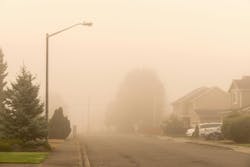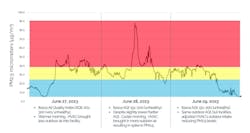How HVAC Pros Can Make a Difference as Wildfire Smoke Creeps Indoors
Key Takeways
- Educate HVAC professionals on proactive measures to safeguard indoor air quality during wildfire smoke episodes.
- Seal gaps around ductwork, windows, and doors to prevent smoke entry into indoor spaces.
- Design buildings with resilience in mind, combining advanced air quality management with energy-efficient systems.
Wildfire smoke has become an unwelcome annual guest across much of North America. It’s become so prevalent that one analysis of 2023 wildfires found that the average American resident experienced nearly 150 days of complete wildfire smoke coverage in their county — a seven-fold increase over the average from 2006 to 2020. Already this year, smoke from Canadian wildfires has blanketed cities thousands of miles away, causing hazy skies and triggering air quality alerts.
While public attention often focuses on the outdoor impacts, the risk wildfires pose to indoor air is just as concerning. In fact, if HVAC systems aren’t optimized during these events, they can unintentionally make indoor air quality (IAQ) worse.
While reactive measures play an important role in protecting building occupant health, shifting climate patterns are leading to more frequent and prolonged wildfire events, making a proactive approach essential. HVAC professionals play a critical role in leading the shift to smarter, preemptive strategies that help safeguard both health and comfort indoors.
The Unique Risks of Wildfire Smoke
Most people have grown accustomed to receiving air quality alerts that notify them of elevated pollution levels and associated health risks. But wildfire smoke presents an especially harmful threat. It contains high levels of particulate matter smaller than 2.5 microns (PM2.5), which can be inhaled deep into the lungs and enter the bloodstream. While it’s commonly believed that wildfire smoke is made up almost entirely of ash from trees and natural debris, the reality is far more concerning. As fires tear through populated areas, they ignite plastics, paint, solvents, rubber, metals, and more, making PM2.5 from wildfires up to 10 times more toxic than that from other sources.
While public health agencies advise staying indoors during wildfire smoke events, being inside doesn’t guarantee protection. One study found that indoor PM2.5 more than doubled on days with wildfire smoke pollution compared to smoke-free days. More surprisingly, HVAC systems can add to the severity of indoor air pollution during a wildfire smoke event. For example, systems using air-side economizers were shown to have significantly higher PM2.5 infiltration factors than other systems — four to five times higher during wildfire events compared to other pollution scenarios, such as dust storms or inversion events.
A clear example of HVAC system impact during a wildfire smoke event was seen at the Itasca, Illinois headquarters of Fellowes Brands during the June 2023 smoke drift caused by Canadian wildfires. Real-time air quality data from the company’s installed IAQ sensors showed a sharp spike in indoor PM2.5 levels when the HVAC system increased outdoor air intake as part of regularly scheduled operation. Once the intake was reduced in response to those readings, PM2.5 levels dropped rapidly — demonstrating the critical impact of timely system adjustments.
The unique characteristics of wildfire smoke particles allow it to infiltrate buildings, even when systems aren’t actively bringing in outdoor air. That’s why HVAC professionals must play offense, not just defense.
What HVAC Pros Can Do Today
When wildfire smoke events are imminent or underway, HVAC professionals must take immediate, reactive action to minimize indoor pollution and protect building occupants. These include:
- Monitor alerts: Sign up for air quality notifications from state and local agencies related to wildfire and other air pollution events, like those from Airnow.gov. Ideally, buildings should be equipped with IAQ sensors that provide real-time monitoring of air quality and immediately alert to the presence of PM2.5.
- Adjust ventilation systems: Temporarily reduce or eliminate outdoor air intake when wildfire smoke is predicted or present. Disabling air-side economizers can help minimize the presence of wildfire smoke PM2.5.
- Upgrade filtration: Install the highest-rated MERV filters the system can accommodate — ideally MERV 13 or above, as these filters are better equipped to capture PM2.5. During wildfire smoke events, filters should be replaced more frequently.
- Inspect building sealing: Seal gaps around ductwork, windows, and doors to reduce infiltration. Even small gaps allow smoke to enter buildings.
- Utilize air purifiers: Utilize commercial-grade air purifiers in high-traffic locations and those used by health-compromised individuals, such as conference rooms, break rooms, classrooms and clinic areas. Select purifiers that offer real-time PM2.5 monitoring and use H13 True HEPA filters, which remove 99.95% of particles as small as 0.1 microns.
Long-term Building Resilience
With more than half the country already experiencing a wildfire smoke event in 2025, building resilience to smoke intrusion has become essential. HVAC professionals must now factor wildfire smoke protection into system design, as well as day-to-day operation and maintenance protocols.
The most resilient buildings today are equipped to manage both IAQ and thermal comfort without sacrificing energy efficiency. Advanced air quality management (AQM) systems can now integrate directly with HVAC and building controls to deliver smarter, more responsive protection. Key strategies include:
- Install real-time IAQ sensors: Equip buildings with sensors that continuously measure particulate matter (including PM2.5), VOCs, and CO2. These sensors provide real-time visibility into IAQ conditions and serve as the foundation for automated system adjustments.
- Pair ventilation with intelligent air purification: Add high-efficiency air purifiers to key building areas and ensure they have the ability to adjust automatically to maintain optimal IAQ levels while optimizing energy usage.
- Integrate all systems through the BMS: Connect IAQ monitoring, HVAC operation, and air purification systems to the centralized building management system (BMS). This integration enables real-time visibility across all IAQ-related functions, ensures a coordinated system response, and allows facilities teams to act quickly and confidently when conditions change due to smoke events or any other situation that deteriorates IAQ.
As the realities of our environment change, so too must the systems we rely on to regulate and protect the air we breathe. For HVAC professionals, this presents a clear opportunity to design systems that go beyond temperature control and comfort to those that work holistically to ensure occupant wellbeing. By anticipating challenges, like those presented by wildfire smoke, and implementing smarter, more responsive technologies, we can ensure that indoor environments remain places of safety and health, regardless of what’s happening outside.
About the Author
Jason Jones
Jason Jones is director of Air Quality Management at Fellowes Brands, where he leads the company’s sales and marketing efforts. He has conducted hundreds of hours of training for Fellowes’ distributors, sales representatives, and end users, helping them better understand the role of smart, responsive air quality management in today’s commercial and institutional spaces.

